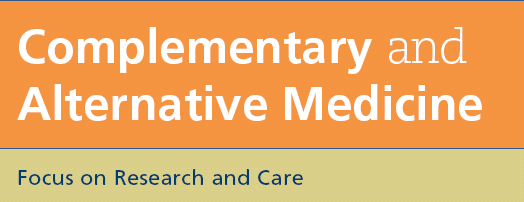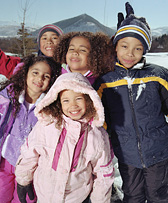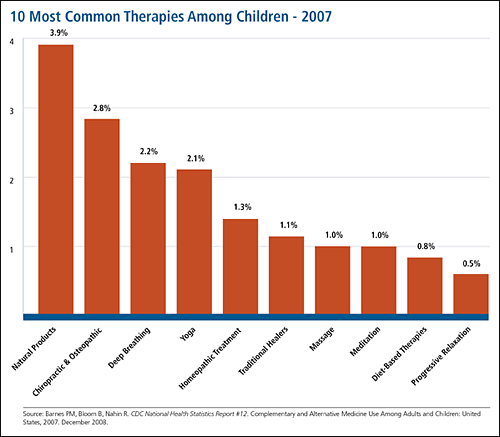NATIONAL CENTER FOR COMPLEMENTARY AND ALTERNATIVE MEDICINE


Children and Complementary and Alternative Medicine

© Vandalay/Getty Images
A wide range of complementary and alternative medicine (CAM) therapies are used in children, including herbs and dietary supplements, massage, acupuncture, chiropractic care, naturopathy, and homeopathy. This fact sheet from the National Center for Complementary and Alternative Medicine (NCCAM) offers information for parents who are thinking about using a CAM therapy for their child.
Patterns of CAM Use in Children
The 2007 National Health Interview Survey gathered information on CAM use among more than 9,000 children aged 17 and under. Nearly 12 percent of the children had used some form of CAM during the past 12 months. CAM use was much more likely among children whose parents also used CAM. Adolescents aged 12-17, children with multiple health conditions, and those whose families delayed or did not use conventional medical care because of cost were also more likely to use CAM. The accompanying figures show survey findings on CAM use by children, including top therapies and diseases/conditions.
In addition, a 2001 survey of 745 members of the American Academy of Pediatrics found that 87 percent of pediatricians had been asked about CAM therapies by a patient or a parent in the 3 months prior to the survey. The pediatricians were asked most often about herbs and dietary supplements.
Safety of Childhood CAM Use
Few high-quality studies have examined how CAM therapies may affect young people, and results from studies in adults do not necessarily apply to children. Children are not small adults. Their immune and central nervous systems are not fully developed, which can make them respond to treatments differently from adults. This is especially true for infants and young children.
Herbs and other dietary supplements may interact with medicines or other supplements, or they may cause problems during surgery, such as bleeding-related complications. In addition, "natural" does not necessarily mean "safe." CAM therapies can have side effects, and these may be different in children than in adults.
Parents should seek information from scientific studies about how safe and effective a specific CAM therapy is in children. However, since few, if any, rigorous studies in young people exist, additional scientific studies are needed. Anecdotes and testimonials (personal stories) about CAM therapies are common and can be compelling, but they are not evidence.
Discussing CAM With Your Pediatrician
Parents often do not tell pediatricians or other health care providers that their child is receiving CAM. It is important, however, that families speak with their child's health care provider about any CAM therapy being used or considered. Providing a full picture of what is being done to manage your child's health will help ensure coordinated and safe care.
If seeking care from a CAM practitioner, it is important to ask about the practitioner's:
- Education and training
- Experience in delivering care to children
- Experience working with other providers, including physicians, to ensure coordinated care
- Licensing (some states have licensing requirements for certain CAM practitioners, such as chiropractors, naturopathic doctors, massage therapists, and acupuncturists).
Additional Points To Consider
In addition to asking your child's physician what is known about whether a therapy works and is safe for children, consider these points when making decisions about using CAM in children:
- Ensure that your child has received an accurate diagnosis from a licensed health care provider and that CAM use does not replace or delay conventional medical care.
- If you decide to use CAM for your child, do not increase the dose or length of treatment beyond what is recommended. More is not necessarily better.
- If your child experiences an effect from a CAM therapy that concerns you, contact your child's health care provider.
- Store herbal and other dietary supplements out of the sight and reach of children.
- If you are a woman who is pregnant or breastfeeding, remember that some CAM therapies may affect your fetus or nursing infant.
For More Information
You can learn more about CAM through the NCCAM Clearinghouse. The Clearinghouse provides a wide range of resources, including:
- Fact sheets with important tips for making decisions about CAM use
- Information on specific types of CAM
- Additional findings from the 2007 NHIS survey on CAM use by adults and children
- Access to other resources, such as online databases where you can search for scientific evidence about CAM therapies you may be considering for your child.
NCCAM Clearinghouse
The NCCAM Clearinghouse provides information on CAM and NCCAM, including publications and searches of Federal databases of scientific and medical literature. The Clearinghouse does not provide medical advice, treatment recommendations, or referrals to practitioners.
Toll-free in the U.S.: 1-888-644-6226
TTY (for deaf and hard-of-hearing callers): 1-866-464-3615
Web site: nccam.nih.gov
E-mail:
Please note that NCCAM does not provide medical advice, treatment recommendations, or referrals to practitioners.

